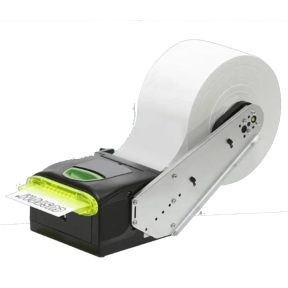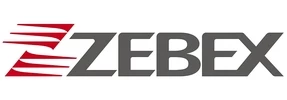THERMAL PRINTERS
Embedded thermal printers for ticket and receipt printing in self‑service kiosks
This category brings together embedded thermal printers designed for self‑service kiosks, ticketing machines, parking and POS terminals. Panel‑mount mechanisms from leading manufacturers such as Custom and Nippon support flexible paper widths (57–86 mm), high print speeds, auto cutters, presenter and retract functions, plus standard RS‑232 / USB / Ethernet interfaces, making integration with industrial controllers straightforward. You can choose between compact receipt engines like the Custom VKP80III and VKP60 compact, heavy‑duty ticket printers such as the KPM180H and KPM302‑III, or embedded units like the Nippon 3511‑D2 and 2511‑D2. Together with the BT‑UC156 embedded label printer and A4 document engines from the KPM216HIII family, these devices provide a robust print platform for demanding B2B kiosk and ticketing applications.
Embedded thermal printers for ticketing, parking and POS systems
Embedded thermal printers are built for unattended environments where the user only interacts with the printed ticket or receipt while the mechanism runs behind a protected front panel in 24/7 operation. Typical applications include vending and ticketing kiosks, parking payment terminals, gate and access control systems, queue‑management kiosks, airport and public transport ticketing, healthcare registration points and POS or cash‑desk solutions. Within this category you will find panel‑mount and open‑frame printers from leading vendors such as Custom and Nippon, optimised for receipt, ticket and label printing in demanding B2B projects.
The portfolio covers classic 80 mm receipt mechanisms, high‑duty ticket printers with cutter and presenter, as well as A4 document engines. Representative models include the Custom VKP80III and VKP60 compact embedded receipt printers, the KPM180H and KPM302‑III heavy‑duty ticket printers, the KPM216HIII A4 document printer family, KPM862 single and dual feeder variants, Nippon 3511‑D2 and 2511‑D2 embedded printers and the BT‑UC156 embedded label printer used where the kiosk must dispense peeled labels instead of receipts.
Key B2B use cases
In professional environments embedded thermal printers provide a reliable backbone for transactional printing wherever unattended customer interaction and high availability are required. Direct thermal technology delivers fast, quiet printouts that are easy to read, helping to keep transaction times short and queues under control.
- ticket vending and parking systems printing tickets, vouchers and barcoded passes;
- POS and retail kiosks issuing receipts, coupons and promotional vouchers;
- access control, gate and queue‑management terminals printing numbered tickets and IDs;
- medical devices and lab equipment printing results, logs and labels at the point of care;
- logistics and parcel lockers generating routing labels, handover slips and tracking tags.
Technology, performance and operating conditions
Most devices in this category use direct thermal technology, printing onto coated media without ribbons, toner or ink cartridges. This reduces the number of moving parts, simplifies maintenance and enables print speeds in the 150–250 mm/s range. Large‑diameter paper rolls cut down on service visits and help keep kiosks online even in remote locations. Combined with robust cutters and presenters, this ensures a clean ticket‑exit experience for untrained end‑users.
Embedded printers typically support paper widths between 57 and 86 mm and offer options such as black‑mark and paper‑end sensors, automatic calibration, full or partial cutting and retract functions. Many models – for example the Custom VKP80III, KPM180H or Nippon 3511‑D2 – are rated for extended temperature ranges, making them suitable for outdoor or semi‑outdoor kiosks. Because thermal prints can fade over time, long‑term archiving is best handled with special long‑life media or digital storage, while day‑to‑day operation benefits from fast, smudge‑free, low‑maintenance printing.
Quality, local technical support and operations
In an unattended kiosk a printer failure effectively takes the whole terminal out of service, so mechanical quality, proven firmware and strong local support are critical. When selecting an embedded printer, it is worth involving the manufacturer or local distributor early in the design phase to validate mechanical integration, paper‑path design, bezel options and electrical or interface requirements. This helps avoid surprises during field trials and roll‑out.
- local technical support and service teams to assist with sizing, integration and troubleshooting;
- planned maintenance for cutter, presenter, rollers and print head to maximise uptime;
- compliance with specified environmental limits (temperature, humidity, dust and moisture protection, stable power);
- use of approved thermal media to protect head life and print quality;
- remote monitoring and logging integrated into the kiosk management platform.
Checklist – selection criteria for embedded thermal printers
- primary use case: ticketing, parking, POS, access control, healthcare or industrial logging;
- media type and width: receipts, fan‑fold or roll tickets, labels (e.g. VKP80III, KPM302‑III, BT‑UC156);
- required print speed and duty cycle based on expected transaction volumes;
- mechanical footprint, mounting points, bezel design and paper‑exit direction;
- interfaces: RS‑232, USB, Ethernet and any GPIO or scanner integration (e.g. KPM862, PP54 EVO);
- operating temperature range and enclosure design for outdoor or semi‑outdoor use;
- supply chain: on‑stock availability, spare parts, paper and accessories over the full lifecycle;
- commercial framework: scheduled deliveries, customs handling, consolidated freight and payment terms.
Supply, logistics and financing for larger deployments
For B2B kiosk projects, technical specifications are only one part of the decision. Roll‑out plans, service models and the commercial framework must also align with the project schedule. Embedded printers in this category can be supplied from stock or via scheduled deliveries aligned with site deployment waves, while logistics partners manage international shipping, customs clearance and consolidated freight.
- warehouse stock and timed deliveries aligned with kiosk installation milestones;
- multiple shipping options and consolidated shipments with customs handling if required;
- post‑delivery payment terms and invoicing in local currency or EUR for contracted partners;
- project‑specific pricing models that reflect total system cost and lifecycle volumes.
FAQ – embedded thermal printers for kiosk projects
How does an embedded thermal printer differ from a standard desktop receipt printer?
An embedded printer is designed to sit behind a kiosk front panel, handle larger paper rolls and work with cutters, presenters or retract modules across a wider temperature range. Consumer‑grade desktop printers typically support smaller rolls, offer less environmental protection and are not intended for 24/7 unattended operation.
What paper width and print speed should you choose for a new kiosk deployment?
For mainstream ticketing and receipt printing, 80 mm high‑speed mechanisms are widely used, while compact kiosks can work well with 58/60 mm media. For high‑traffic locations look for devices such as VKP80III or KPM180H that combine 150–200 mm/s print speeds with large roll capacity to minimise service visits.
How can you extend the service life of an embedded thermal printer in industrial environments?
Use the media recommended by the manufacturer, respect environmental limits for temperature and humidity, and design sufficient airflow into the enclosure. Plan regular preventive maintenance: cleaning the print head, rollers, cutter and presenter significantly reduces unplanned downtime.
Which extra features do industrial kiosk printers offer compared to entry‑level devices?
Industrial‑grade printers often add barcode and QR‑code printing, black‑mark detection, high‑capacity roll holders, multiple interfaces (USB, RS‑232, Ethernet), vandal‑resistant bezels and retracting presenters. These features are rarely available on consumer desktop printers but are standard requirements in unattended kiosk applications.
CTA – build your project shortlist using the enquiry list
For ongoing and future kiosk projects it is useful to collect all potentially relevant printers into a single shortlist. Use the enquiry list to add embedded printers that might fit different roll sizes, kiosk layouts or cost targets, even if the final decision is not made yet. At the end of your visit you can submit the consolidated list and receive a project‑specific proposal together with technical guidance.
- add all printers that could work across your current and upcoming kiosk projects to the enquiry list;
- include alternative models with different paper widths, bezels or interfaces to keep options open;
- submit the list in one step to trigger a consolidated technical and commercial response;
- use the feedback to fine‑tune your bill of materials and rollout schedule.











